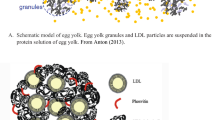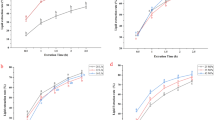Abstract
Egg-yolk lecithin has phospholipid (PL) classes and a FA composition that differ from soybean lecithin and may have unique functional properties. The purposes of this research were to develop an effective method for extracting a sufficient amount to lecithin from fresh egg yolks and to evaluate its functional properties. Ethanol was used to dehydrate and partially extract the PL, after which hexane was used to extract the total lipids. A phase separation of the combined extracts resulted in neutral and polar lipid fractions. An acetone precipitation of PL from the final polar lipid fraction was necessary to remove the residual neutral lipids, especially cholesterol. The purity of PL in the lecithin product was 95%. Surface tension reduction, emulsion stability, and oxidative stability studies were conducted to characterize the functional properties of egg-yolk lecithin. Egg-yolk lecithin and soy lecithin had similar surface activities, as evaluated by the surface tension reduction in an aqueous system and the critical micelle concentration. Soybean lecithin created a more stable emulsion than egg-yolk lecithin. However, egg-yolk lecithin was more oxidatively stable than soybean lecithin.
Similar content being viewed by others
References
Chi, Y., and S. Lin, Research Advances in Extraction and Application of Egg-Yolk Lecithin, Food Ferment. Ind 28:50–53 (2002).
Sim, J.S., New Extraction and Fractionation Method for Lecithin and Neutral Oil from Egg Yolk, in Egg Uses and Processing Technologies, edited by J.S. Sim and S. Nakai, CAB International, Wallingford, United Kingdom, 1994, pp. 128–138.
Jiang, Y., S.K. Noh, and S.I. Koo, Egg Phosphatidylcholine Decreases the Lymphatic Absorption of Cholesterol in Rats, J. Nutr. 131:2358–2363 (2001).
Nielson, H., In situ Solid Phase Extraction of Phospholipids from Heat Coagulated Egg Yolk by Organic Solvents, Lebensm.-Wiss. Technol. 34:526–532 (2001).
Larsen, J.E., and G.W. Froning, Extraction and Processing of Various Components from Egg Yolk, Poultry. Sci. 60:160–167 (1981).
Tokarska, B., and M.T. Clandinin, Extraction of Egg Yolk Oil of Reduced Cholesterol Content, Can. Inst. Food Sci. Tech. J. 18:256–258 (1985).
Sim, J.S., Extraction of Fresh Liquid Egg Yolk, Canadian Patent 1,335,054 (1995).
Miyata, K., and H. Matsumoto, Manufacture of Purified Egg-Yolk Lecithins, Japanese Patent 2,001,072,693 (2001).
Hruschka, S.M., S. Kirchner, J. Rassenhovel, and W. Witt, Method for the Fractionation of Oil and Polar Lipid-Containing Native Raw Materials, U.S. Patent 20,030,054,084 (2003).
Galanos, D.S., and V.M. Kapoulas, Isolation of Polar Lipids from Triglyceride Mixtures, J. Lipid Res. 3:134–137 (1962).
Wu, Y., and T. Wang, Soybean Lecithin Fractionation and Functionality, J. Am. Oil Chem. Soc. 80:319–326 (2003).
Driver, M.G., R.B. Koch, and H. Salwin, Modified Procedure for the Determination of Peroxide Values of Fats by the Ferric Thiocyanate Method, J. Am. Oil Chem. Soc. 40:504–505 (1963).
AOCS, Official Methods and Recommended Practices of the American Oil Chemists' Society, 4th edn., AOCS Press, Champaign, IL, 1994.
Christie, W.W., The Analysis of Simple Lipid Classes, in Lipid Analysis, edited by W.W. Christie, Pergamon Press, New York, 1982, pp. 93–106.
Rhodes, D.N., and C.H. Lea, Phospholipids. IV. Composition of Hen Egg Phospholipids, Biochem. J. 65:526–33 (1957).
Maeba, R., and N. Ueta, Ethanolamine Plasmalogen Prevent the Oxidation of Cholesterol by Reducing the Oxidizability of Cholesterol in Phospholipid Bilayers, J. Lipid Res. 44:164–171 (2003).
Zommara, M., N. Tachibana, K. Mitsui, N. Nalatani, M. Sakono, I. Ikeda, and K. Imaizumi, Inhibitor Effect of Ethanolamine Plasmalogen on Iron- and Copper-Dependent Lipid Extraction, Free Radical Biol. Med. 18:599–602 (1995).
Fatemi, S.H., and E.G. Hammond, Analysis of Oleate, Linolenate and Linolenate Hydroperoxides in Oxidized Ester Mixtures, Lipids 15:379–385 (1980).
Hammond, E.G., L.A. Johnson, P.J. White, T. Wang, and C. Su, Soybean Oil, in Bailey's Industrial Oil and Fat Products, 6th edn., edited by F. Shahidi, John Wiley & Sons, New York, in press.
Spickett, C.M., N. Rennie, H. Winter, L. Zambonin, L. Landi, A. Jerlich, R.J. Schaur, and A.R. Pitt, Detection of Phospholipid Oxidation in Oxidatively Stressed Cells by Reversed-Phase HPLC Coupled with Positive-Ionization Electrospray MS, Biochem. J. 355:449–457 (2001).
Author information
Authors and Affiliations
Corresponding author
About this article
Cite this article
Palacios, L.E., Wang, T. Egg-yolk lipid fractionation and lecithin characterization. J Amer Oil Chem Soc 82, 571–578 (2005). https://doi.org/10.1007/s11746-005-1111-4
Received:
Accepted:
Issue Date:
DOI: https://doi.org/10.1007/s11746-005-1111-4




